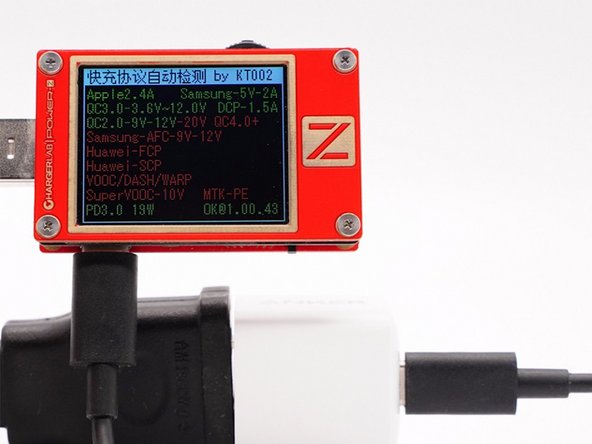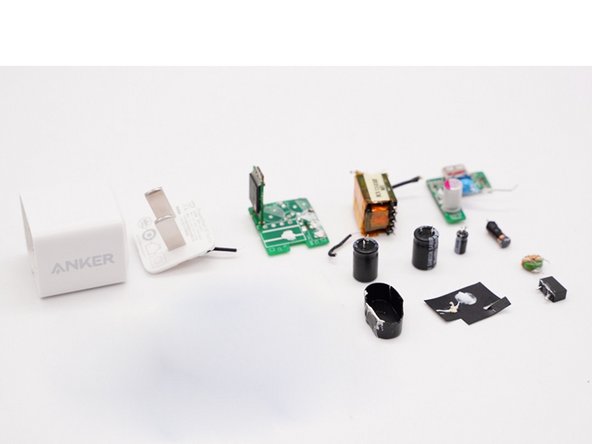crwdns2915892:0crwdne2915892:0
Anker Anker Nano 20W PD Charger. The biggest feature of this charger is its small size. By comparison, its volume is only the size of Apple's original 5V/1A charger, and its power density is 4 times that of the latter. The following charging head network disassembles this charger to see how its interior is designed.
crwdns2936621:0crwdne2936621:0
-
-
Anker Nano 20W PD Charger. The biggest feature of this charger is its small size. By comparison, its volume is only the size of Apple's original 5V/1A charger, and its power density is 4 times that of the latter. The following charging head network disassembles this charger to see how its interior is designed.
-
1.Appearance of Anker Nano 20W PD charger
-
The product follows Anker's typical blue and white color packaging box, with the ANKER brand and lightning logo printed on the front.
-
On the back are the three major features of the product and related parameter information.
-
The package includes a charger and an instruction manual
-
-
-
The charger adopts PC flame-retardant material white shell, the top surface of the output is bright, and the other sides are frosted. The body of the charger as a whole tends to be a cube, which is very compact.
-
One of the sides is designed with the ANKER brand, and the input end is equipped with fixed national standard pins.
-
The charger parameter information is marked on the input shell Model: A2633 Input: 200-240V~50HZ 0.6A Output: 5V3A, 9V2.22A Anker Innovation Technology Co., Ltd. The product has passed the CCC certification
-
-
-
The top surface of the output is equipped with a USB-C interface, the blue plastic core does not expose copper, and there is a blue lightning logo and PowerIQ 3.0 logo next to the interface, which is very recognizable.
-
Using a vernier caliper to measure the length of the charger body is 29.82mm.
-
The width is 27.25mm.
-
-
-
The thickness is also 27.25mm and the cross section is square.
-
Compared with the size of a one-yuan coin, the cross-section of the charger is slightly larger.
-
Compared with the size of the Apple 18W charger, the size advantage is obvious.
-
-
-
Intuitive feeling in hand.
-
The net weight of the charger is about 30g.
-
-
-
-
Using ChargerLAB POWER-Z KT002 to detect the output protocol of the USB-C port, it shows that it supports Apple 2.4A, Samsung 5V/2A and DCP protocols, as well as QC2.0, QC3.0, PD3.0 fast charging protocols.
-
In addition, its PDO message shows that the USB-C port has two sets of fixed voltage levels of 5V3A and 9V2.22A.
-
-
-
Disassemble the shell of the input end, the shell is packaged by ultrasonic welding process, and the pins and PCB board are connected to power through AC wires.
-
The interior of the charger is composed of three small boards, and power chips are welded between the input and output small boards. This design can maximize the use of internal space and reduce the size of the charger.
-
The small plate at the output end corresponds to the hollow design of the transformer, and the transformer is placed and fixed with glue to make full use of the internal space and further reduce the volume.
-
After observing and analyzing the three PCB boards, it is found that the Anker Nano 20W PD charger adopts a typical switching power supply with a wide range of output, and the design architecture of the output voltage is controlled by the secondary protocol chip. Let's start from the input end to understand each component one by one.
-
-
-
The components on the two boards are glued and fixed, and the top of the electrolytic capacitorhas an insulating sleeve and is insulated with high-temperature tape.
-
Close-up of the time-delay fuse, the specification is 2A 250V
-
A close-up of the common mode inductor is used to filter out EMI interference.
-
-
-
There is a rectifier bridge on the back of the primary board
-
Chongqing Pingwei ABSR210 rectifier bridge close-up, current 2A, reverse withstand voltage 1000V.
-
An insulating isolation board is pasted on the side where the transformer is located.
-
-
-
On the other side, the top of the capacitor is covered with an insulating tube for insulation.
-
The two high-voltage filter electrolytic capacitors are SAMXON brand, and the specifications are both 10μF 400V.
-
A close-up of the I-shaped inductor.
-
-
-
The main control chip power supply capacitor is from Aihua, the specification is 50V 10μF.
-
The main control chip of the charger is installed on the small board connecting the primary and secondary, and the transformer is placed on the right side.
-
The main control chip of the charger comes from PI, which is the same supplier as Apple's 18W PD fast charge. Model INN3265C, built-in primary PWM controller, switching tube and secondary synchronous rectification controller, high integration, support wide voltage input, 22W output power.
-
-
-
The transformer is wrapped in insulating tape with an information label attached to the side.
-
A synchronous rectification MOS tube and a protocol chip are provided on the back of the secondary board.
-
Remove the small board, and there are Y capacitors, solid capacitors and output VBUS switch tubes on the front
-
-
-
A close-up of the output anti-interference blue Y capacitor, from Dongguan Chengxi Electronics Co., Ltd.
-
UBIQ QN0102M6N secondary synchronous rectifier tube, NMOS, withstand voltage 100V, conduction resistance 6mΩ.
-
Synchronous rectification output filter solid capacitor, specification 16V 470μF, Man Yue ULR series.
-
-
-
The USB PD protocol IC adopts Cypress CYPD3175, supports 1A1C interface, supports QC4.0 and other fast charging protocols, integrates secondary feedback and output current detection amplifier, built-in multiple perfect system-level protection, built-in 32-bit MCU, built-in clock , support a wide operating voltage range.
-
The VBUS switch tube output by the USB-C port adopts UBIQ QM3017AM3, PMOS, with a withstand voltage of 30V.
-
Close-up of USB-C socket, blue plastic core, through-hole soldering.
-
-
-
The Anker Nano 20W PD charger can be described as a mini. It integrates 20W power into the ultra-small body. Compared with Apple's original 5W charger, the power density is 4 times that of it, taking into account the charging speed and charging of mobile phones. Small size, easy to use.
-
The USB-C port supports Apple 2.4A, QC2.0, QC3.0, and PD3.0 protocols, and has two sets of voltage levels of 5V3A and 9V2.22A. This charger uses a switching power supply with a wide range of output and a secondary protocol chip Typical architecture for controlling the output voltage.
-
The AC-DC part of the charger is composed of PI highly integrated main control chip INN3265C and UBIQ secondary synchronous rectification MOS, and uses Cypress USB PD fast charging protocol chip CYPD3175 to control the output voltage.
-
Anker uses Apple's 18W charger from the same factory Chip, in addition, the charger adopts a structure design similar to "sandwich biscuits".
-
The components such as electrolytic capacitors and transformers are arranged between the input and output boards. The components are fixed with glue, which not only effectively compresses the volume of the charger, but also makes the interior more stable.
-
Capacitors and transformers are protected with insulating tubes and wrapped with tape. The ultra-small body of Anker Nano 20W PD charger is created by the combination of highly integrated fast charging solution and ingenious design.
-

















































































